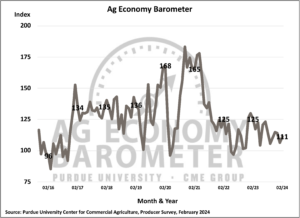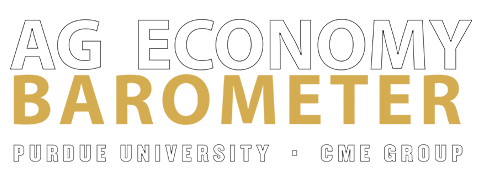Modest improvement in farmer sentiment, yet financial concerns loom
The latest Purdue University/CME Group Ag Economy Barometer reveals a modest increase in farmer sentiment compared to the previous month, though concerns remain regarding farm financial performance in the year ahead.

Modest improvement in farmer sentiment, yet financial concerns loom. (Purdue/CME Group Ag Economy Barometer/James Mintert)
The February barometer reading reached 111, marking a 5-point rise from last month. The small uptick is attributed to producers expressing increased optimism about the future, with the Future Expectations Index climbing 7 points to 115. However, the Current Conditions Index remained unchanged. Despite their improved outlook for the future, farmers’ financial performance expectations did not keep pace. February’s Farm Financial Performance Index registered at 85, a slight dip from January and notably lower than its recent peak in December. The February survey was conducted from Feb. 12-16.
“Weak crop prices continue to weigh heavily on financial expectations, with mid-February Eastern Corn Belt cash prices for corn and soybeans declining by 7% and 8%, respectively, compared to two months earlier,” said James Mintert, the barometer’s principal investigator and director of Purdue University’s Center for Commercial Agriculture.
When producers were asked about their primary concerns for farm operations in the upcoming year, the top concern cited by 34% of respondents was “high input costs,” closely followed by “lower crop/livestock prices,” chosen by 28% of respondents. Worries about rising interest rates among producers seem to have diminished somewhat, with only 18% of February respondents citing it as a top concern, down from 26% who did so in November.
The Farm Capital Investment Index remains weak at 34 points, 9 points lower than last year. Producers expressing reluctance toward making large investments highlighted concerns over high production costs and weak output prices. The percentage of farmers worried about farm profitability has tripled since last October. This month, 22 out of every 100 farmers pointed to farm profitability concerns, while last fall only 7 out of every 100 farmers felt the same way.
The Short-Term Farmland Values Expectations Index held steady in comparison to January but declined by 4 points from a year ago and by 30 points from two years ago. Although the farmland index remains positive, it is clear that overall sentiment regarding future increases in farmland values is weaker than it was a couple of years ago. Among producers who expect values to increase in the next year, the top reason cited for their optimism was demand from non-farm investors.
Each February, the barometer survey asks producers about growth plans for their farm operation in the upcoming five years. This year, 4 out of 10 respondents expressed no plans for growth, with 14% saying they plan to exit or retire. Alternatively, just over 3 out of 10 respondents anticipate their farm’s annual growth rate to exceed 5%. Responses to this question, which have been consistent in recent years, point to further consolidation among farm operations.
“To put growth rates into perspective, consider that a farm operation growing at a 5% annual rate will double in size in about 14 years, whereas a farm growing at an annual rate of 10% will need just seven years to double,” Mintert said.
Interest in leasing farmland for solar energy development remains strong, with 10% of respondents having discussed such projects in the last six months. Rates varied widely, but over half of the respondents reported being offered lease rates of $1,000 per acre or more. The top end for solar lease rates appears to be rising over time. When this question was posed in June 2021, just 27% of respondents reported a lease rate offer of $1,000 or more per acre, compared to 56% of respondents this year.
About the Purdue University Center for Commercial Agriculture
The Center for Commercial Agriculture was founded in 2011 to provide professional development and educational programs for farmers. Housed within Purdue University’s Department of Agricultural Economics, the center’s faculty and staff develop and execute research and educational programs that address the different needs of managing in today’s business environment.
About CME Group
As the world’s leading derivatives marketplace, CME Group (www.cmegroup.com) enables clients to trade futures, options, cash and OTC markets, optimize portfolios, and analyze data – empowering market participants worldwide to efficiently manage risk and capture opportunities. CME Group exchanges offer the widest range of global benchmark products across all major asset classes based on interest rates, equity indexes, foreign exchange, energy, agricultural products and metals. The company offers futures and options on futures trading through the CME Globex® platform, fixed income trading via BrokerTec and foreign exchange trading on the EBS platform. In addition, it operates one of the world’s leading central counterparty clearing providers, CME Clearing.
CME Group, the Globe logo, CME, Chicago Mercantile Exchange, Globex, and, E-mini are trademarks of Chicago Mercantile Exchange Inc. CBOT and Chicago Board of Trade are trademarks of Board of Trade of the City of Chicago, Inc. NYMEX, New York Mercantile Exchange and ClearPort are trademarks of New York Mercantile Exchange, Inc. COMEX is a trademark of Commodity Exchange, Inc. BrokerTec and EBS are trademarks of BrokerTec Europe LTD and EBS Group LTD, respectively. The S&P 500 Index is a product of S&P Dow Jones Indices LLC (“S&P DJI”). “S&P®”, “S&P 500®”, “SPY®”, “SPX®”, US 500 and The 500 are trademarks of Standard & Poor’s Financial Services LLC; Dow Jones®, DJIA® and Dow Jones Industrial Average are service and/or trademarks of Dow Jones Trademark Holdings LLC. These trademarks have been licensed for use by Chicago Mercantile Exchange Inc. Futures contracts based on the S&P 500 Index are not sponsored, endorsed, marketed, or promoted by S&P DJI, and S&P DJI makes no representation regarding the advisability of investing in such products. All other trademarks are the property of their respective owners.
About Purdue University
Purdue University is a public research institution demonstrating excellence at scale. Ranked among top 10 public universities and with two colleges in the top four in the United States, Purdue discovers and disseminates knowledge with a quality and at a scale second to none. More than 105,000 students study at Purdue across modalities and locations, including nearly 50,000 in person on the West Lafayette campus. Committed to affordability and accessibility, Purdue’s main campus has frozen tuition 13 years in a row. See how Purdue never stops in the persistent pursuit of the next giant leap — including its first comprehensive urban campus in Indianapolis, the new Mitchell E. Daniels, Jr. School of Business, and Purdue Computes — at https://www.purdue.edu/president/strategic-initiatives.
Writer: Erin Robinson, erobin@purdue.edu
Source: James Mintert, 765-494-7004, jmintert@purdue.edu
Media Contacts:
Aissa Good, Purdue University, 765-496-3884, aissa@purdue.edu
Dana Schmidt, CME Group, 312-872-5443, dana.schmidt@cmegroup.com
Photo Caption:
Modest improvement in farmer sentiment, yet financial concerns loom. (Purdue/CME Group Ag Economy Barometer/James Mintert)


